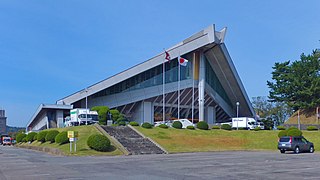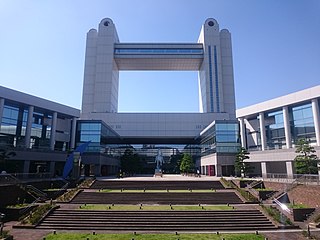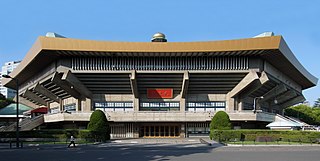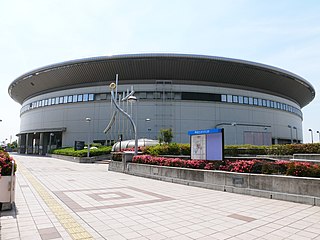 W
WAichi Prefectural Gymnasium , also known as Dolphins Arena , is a multi-purpose gymnasium in Nagoya, Japan, built in 1964. Located on the site of the secondary enclosure of Nagoya Castle, it is host to numerous concerts and events. The gymnasium has 4,375 fixed seats, and can accommodate an additional 3,032 on the floor for certain events, giving it a total maximum capacity of 7,407.
 W
WAkita Prefectural Gymnasium is a stadium in Akita, Akita Prefecture, Japan.
 W
WAriake Coliseum is an indoor sporting arena in Ariake Tennis Forest Park located in Ariake, Kōtō|, Tokyo, Japan. It has a capacity of 10,000 and is one of the few professional tennis venues which has a retractable roof.
 W
WCNA Arena Akita is an arena in Rinkai-area, Akita, Japan. It is owned and run by the city.Cable Networks Akita acquired its naming rights in 2015. The silver-colored building opened in 1994 and holds 5,000 people. The gym has a dome-shaped 154 feet height ceiling, and added 2,088 extra seatings in 2016. It is the home arena of the Akita Northern Happinets of the B.League, Japan's professional basketball league. The biggest basketball court in Akita is Akita Prefectural Gymnasium.
 W
WDiffer Ariake was an indoor sporting arena located in the Ariake neighborhood of Tokyo, Japan. The capacity of the arena is 1,246 seats and it was opened in 1999. It was mainly used for professional wrestling and martial arts events. The arena became known as the home of Pro Wrestling Noah, housing the promotion's offices and training dojo.
 W
WHiroshima Prefectural Sports Center is an indoor arena located in Hiroshima, Japan. The original arena was built sometime shortly after World War II. The arena was rebuilt for the 1994 Asian Games. It hosted some of the group games for the 2006 FIVB Men's World Championship and the official 2006 Basketball World Championship.
 W
WKamei Arena Sendai is an indoor sporting arena located in Sendai, Miyagi, Japan. The capacity of the arena is 7,000. It hosted preliminary round games for the Basketball World Championship 2006, and is also the home arena of the Sendai 89ers of the Japan professional basketball B.League. In 1994 and 2004, it hosted the Asian Basketball Championship for Women.
 W
WKorakuen Hall is an arena in Bunkyo, Tokyo, Japan, which has hosted many boxing, professional wrestling, kickboxing, mixed martial arts and Lethwei matches. The hall is inside the Tokyo Dome City, it is one of Tokyo's biggest attractions. It opened on April 16, 1962, and has a capacity of approximately 2,005 people.
 W
WThe Nagoya Congress Center is a multi-purpose convention center, in the city of Nagoya, Aichi Prefecture, Japan.
 W
WNippon Budokan , often shortened to simply Budokan, is an indoor arena located in Chiyoda, Tokyo, Japan. Originally built for the inaugural Olympic judo competition in the 1964 Summer Olympics, its name translates as Martial Arts Hall in English. While its primary purpose is to host martial arts contests, the arena has gained additional fame as one of the world's most iconic musical performance venues. Budokan was a popular venue for Japanese professional wrestling for a time, and it has hosted numerous other sporting events such as the 1967 Women's Volleyball World Championship. Most recently, the arena hosted the Olympic debut of karate in the 2020 Summer Olympics as well as the judo competition at both the 2020 Summer Olympics and the 2020 Summer Paralympics.
 W
WNagoya Civic General Gymnasium , formerly Nagoya Rainbow Hall, is an indoor sports arena located in Nagoya, Japan. From April 1, 2007, its name was changed to Nippon Gaishi Hall, to reflect the sponsorship of the NGK Insulators. The capacity of the arena is 10,000 people.
 W
WOsaka Municipal Central Gymnasium is an indoor sporting arena located in Minato-ku, Osaka City, Osaka Prefecture, Japan. The arena opened on 1996.
 W
WOsaka Prefectural Gymnasium is an indoor sporting arena located in Namba, Osaka, Japan. It first opened in 1952 and the current building was constructed in 1987. It is the venue of a professional sumo tournament (honbasho) held in March every year. The capacity of the arena is 8,000 people. Its total revenue for the 2006 fiscal year was 260 million yen, of which sumo provided 80 million.
 W
WOsaka-jō Hall is a multi-purpose arena located in the Kyōbashi area of Osaka, Japan. The hall opened in 1983 and can seat up to 16,000 people. Built on a site area of 36,351 square meters, part of its form uses stone walls, modeled after those of the Castle and it won the Osaka Urban Scenery Architects Prize Special Award in 1984.
 W
WRyōgoku Kokugikan (両国国技館), also known as Ryōgoku Sumo Hall or Kokugikan Arena, is an indoor sporting arena located in the Yokoami neighborhood of Sumida, one of the 23 wards of Tokyo in Japan, next to the Edo-Tokyo Museum. It is the third building in Tokyo associated with the name kokugikan ; the current building was opened in 1985 and has a capacity of 11,098 people.
 W
WSaitama Super Arena is a multi-purpose indoor arena located in Chūō-ku, Saitama, Saitama Prefecture, Japan. It opened preliminarily on May 5, 2000, and then officially opened on September 1 of the same year. Its spectator capacity is 36,500 at maximum settings, making it the second-largest indoor arena in the world. The main arena capacity is between 19,000 and 22,500.
 W
WShinjuku Face is an event hall located on the 7th floor of the Humax Pavilion Shinjuku complex, 1-20-1 Kabukicho, Tokyo, Japan. It mainly hosts mixed martial arts, boxing and professional wrestling events. Shinjuku Face has a capacity of approximately 600 people.
 W
WTokyo Metropolitan Gymnasium is a sporting complex in Sendagaya, Shibuya, Tokyo, Japan. Built in 1954 for the World Wrestling Championship, it was also used as the venue for gymnastics at the 1964 Summer Olympics, and hosted the table tennis competition at the 2020 Summer Olympics. The gymnasium was rebuilt to a futuristic design created by Pritzker Prize winner Fumihiko Maki from 1986 to 1990.
 W
WWorld Memorial Hall or World Hall is a multi-purpose arena located in the Chūō-ku Ward of Kobe, Japan. It has a maximum capacity of 8,000 people and is optimized for large-scale meetings, sport events, trade shows and concerts. It is located on the artificial island of Port Island, along with numerous convention centers, hotels and universities.
 W
WXebio Arena Sendai (ゼビオアリーナ仙台) is an arena in Sendai, Miyagi, Japan. It is the home arena of the Sendai 89ers of the B.League, Japan's professional basketball league.
 W
WYokohama Arena is an indoor arena located in Yokohama, Japan. The capacity of the arena is 17,000 and was opened in 1989. The arena was modeled after US sports venue Madison Square Garden in New York City. It is a five-minute walk from the closest station, Shin-Yokohama Station on the JR/Yokohama Municipal Subway.
 W
WYokohama Cultural Gymnasium is an indoor sports arena located in Naka-ku, Yokohama, Japan. The capacity of the arena is 5,000 people and was opened in 1962.
 W
WYoyogi National Gymnasium is an indoor arena located at Yoyogi Park in Shibuya, Tokyo, Japan, which is famous for its suspension roof design.